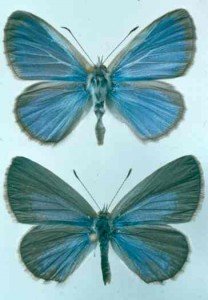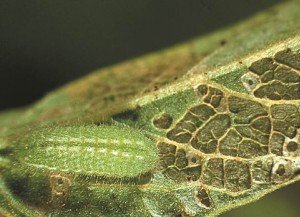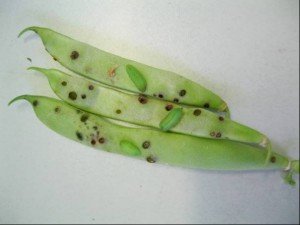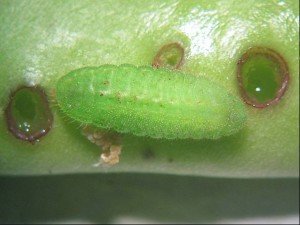The larvae of the grass blue butterfly (Zizina labradus) are normally minor leaf feeding pests, although they can be damaging in seedling crops where they attack terminals and axillary buds.
Soybeans are their favoured summer pulse host, but they can also attack other pulses including navy beans.
Damage
Recently, grass blue butterfly larvae have been observed causing major pod damage in a crop of navy beans. Small larvae fed initially on the leaves, where they caused only very minor damage. However, larger larvae suddenly switched to attacking pods in the early podfill stage. This behaviour is highly unusual and has resulted in major pod damage.
Pod damage was characterized by multiple holes per pod, made by individual larva. Some holes were fairly shallow, but others were deeper and reached the seeds. Many of the holes secreted sap and the edge of the holes turned black. These holes are likely to result in the weathering of those seeds not yet damaged directly.
The ‘multiple holes per pod’ damage looks very much like that caused by helicoverpa in Faba beans. A possible explanation is that larvae boring inwards are ‘suffocated’ by sap oozing into the holes, forcing them to retreat and to try again, to the detriment of the pods appearance and its capacity to protect the seeds from weathering.
Managing Grass Blue
No pesticides are registered specifically against grass blue butterfly in summer pulses. Grass blue larvae will be controlled by insecticides targeting other caterpillars such as helicoverpa. Dipel or Bt (Bacillus thuringiensis) is also effective against grass blue and although larvae do not die immediately, they stop feeding. Thorough coverage is essential with Bt (at least 100L water/ha) and should target small larvae feeding on leaves, before they move to the pods. Look for the early warning signs, in this case, the adult butterflies fluttering over the crop in question, followed by numerous small leaf windows made by small larvae.




